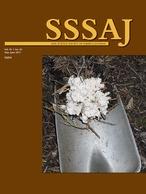View Item
- xmlui.general.dspace_homeCentros Regionales y EEAsCentro Regional Buenos Aires SurEEA BalcarceArtículos científicosxmlui.ArtifactBrowser.ItemViewer.trail
- DSpace Home
- Centros Regionales y EEAs
- Centro Regional Buenos Aires Sur
- EEA Balcarce
- Artículos científicos
- View Item
Can edaphic variables improve DTPA-Based zinc diagnosis in corn?
Abstract
Current zinc (Zn) diagnostic methods for corn (Zea mays L.) are often based on soil DTPA (diethylenetriamine-pentaacetic acid) extractable Zn (DTPA-Zn). However, calibration of the DTPA-Zn test may be influenced by other soil properties such as pH, organic matter (SOM) and available Bray-P (PBray-1). Our objective was to assess the contribution of soil properties to a DTPA-Zn model used to predict corn response to Zn fertilization. We conducted 64 field
[ver mas...]
Current zinc (Zn) diagnostic methods for corn (Zea mays L.) are often based on soil DTPA (diethylenetriamine-pentaacetic acid) extractable Zn (DTPA-Zn). However, calibration of the DTPA-Zn test may be influenced by other soil properties such as pH, organic matter (SOM) and available Bray-P (PBray-1). Our objective was to assess the contribution of soil properties to a DTPA-Zn model used to predict corn response to Zn fertilization. We conducted 64 field trials with two Zn-fertilization treatments: with and without Zn fertilization. In all sites, we measured SOM, PBray-1, pH, and DTPA-Zn at 0- to 20-cm depth before sowing. Yield difference between Zn-fertilized and unfertilized treatments (Ydifference) was significant in 33% of the experimental site-years. In responsive site-years, the average Ydifference was 0.98 Mg ha-1 (11.4%). Soil organic matter was the only property that was a significant addition to the DTPA-Zn model for predicting the corn relative yield (Model R2 including SOM = 0.27). However, the improvement was nominal (Partial R2 of SOM = 0.06). Use of DTPA-Zn alone was suitable to discriminate Zn responsiveness among site-years based on the Ydifference by correctly diagnosing 81% of the outcomes. We determined three soil DPTA-Zn ranges with different probability of resulting in a Ydifference greater than zero when fertilized with Zn: high (<0.9 mg kg-1), medium (0.9–1.3 mg kg-1), and low (>1.3 mg kg-1). These soil-test-based Zn recommendations improve the identification of Zn-deficient soils allowing prevention of yield loss from Zn deficiency and more rational use of Zn fertilizers.
[Cerrar]

Author
Barbieri, Pablo;
Sainz Rozas, Hernan Rene;
Wingaard, Nicolás;
Eyherabide, Mercedes;
Reussi Calvo, Nahuel Ignacio;
Salvagiotti, Fernando;
Correndo, Adrián A.;
Barbagelata, Pedro Anibal;
Espósito Goya, Gabriel Pablo;
Colazo, Juan Cruz;
Echeverria, Hernan Eduardo;
Fuente
Soil Science Society of America journal 81 (3) : 556-563. (2017)
Date
2017-06-01
ISSN
1435-0661
Formato
pdf
Tipo de documento
artículo
Palabras Claves
Derechos de acceso
Restringido
 Excepto donde se diga explicitamente, este item se publica bajo la siguiente descripción: Creative Commons Attribution-NonCommercial-ShareAlike 2.5 Unported (CC BY-NC-SA 2.5)
Excepto donde se diga explicitamente, este item se publica bajo la siguiente descripción: Creative Commons Attribution-NonCommercial-ShareAlike 2.5 Unported (CC BY-NC-SA 2.5)

